A Brecks Tour today, a single day tour down in Thetford Forest. After a misty start, it was forecast to be cloudy but dry. We met at Lynford Arboretum in the morning and went off to explore the Forest.
Our first stop was at Santon Downham. A Greenfinch was singing in the car park as we got out. On our way down towards the bridge, we could see a single duck flying west along the river and a quick look through binoculars confirmed it was a drake Mandarin as it disappeared into the trees. Down at the bridge, a pair of Grey Wagtails were flitting about, flying up from the bank to the small trees nearby. The male was singing. But a dog walker returning along the riverbank path flushed them, and they flew off upstream.
As we set off along the riverbank ourselves, there were lots of finches in the bushes. They appeared to be dropping in to bathe and drink, and several were drying themselves out and preening. As well as the local Chaffinches, there were several Bramblings and Siskins. We stopped to have a look at them through the scope.
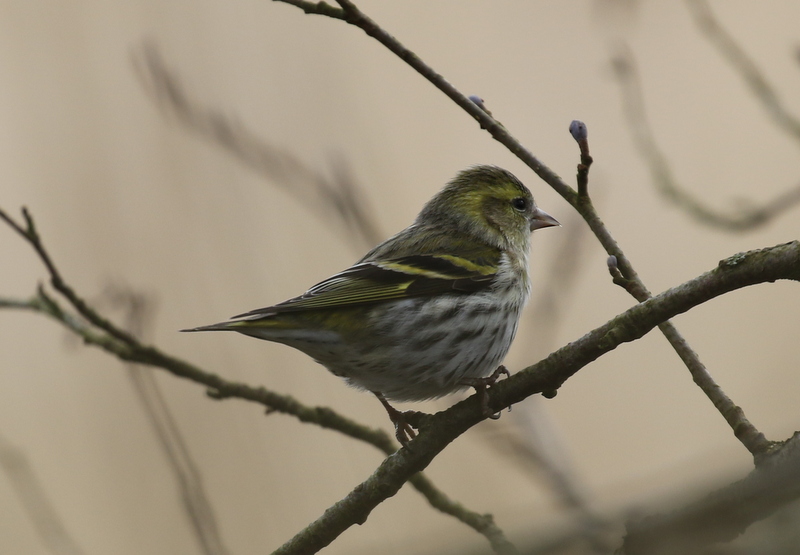 Siskin – there were lots down along the river again this morning
Siskin – there were lots down along the river again this morning
As we walked along, we could hear a Chiffchaff singing, the first we have heard this year, and a real sign that spring is on its way. It appears that there had been a large arrival of Chiffchaffs across the county today, so this was probably a fresh returning bird. A Woodlark started singing too, and we looked across to see a pair distantly, flying around over a cleared area, before dropping down towards the ground out of view. A Common Crossbill flew over calling and several Nuthatch were piping noisily from the trees.
Our main target here was Lesser Spotted Woodpecker, but we knew we would need a bit of luck. We didn’t have much time to spend here this morning, with so many other things to do, and they can roam very widely at this time of day. Thankfully, we bumped into one of the locals returning along the path who tipped us off that one had been seen not long earlier just a short distance further ahead, although it had flown off across the river and disappeared. We positioned ourselves in the right spot and listened.
Thankfully, after just a couple of minutes, we heard a Lesser Spotted Woodpecker calling from across the river. It was some distance back in the alders, but helpfully chose that moment to fly back to our side. We saw it as it flew across the river, getting a good sense of how small it was in flight. It carried on over the tops of the trees and landed high up in the back. We managed to get it in the scope, but unfortunately only a couple of the group were able to look at it before it moved again. It was a female, with a black crown.
We could see where it dropped so we repositioned ourselves and found the Lesser Spotted Woodpecker again, high in the birches at the back. However, just as we got the scope on it, it flew off back behind the trees. We waited a while, hoping it would reappear. We could still hear it calling occasionally.
While we waited, there were several other nice birds to look at. A male Crossbill was flitting about high in the trees, picking at the bark. It perched up preening for a while, where we could get it in the scope. We could even hear it singing at one point. A flock of redpolls flew in and landed in the birches and through the scope we could see they were Lesser Redpolls, small and rather brown-toned. A couple of Green Woodpeckers laughed at us from the trees, and we could hear a couple of Great Spotted Woodpeckers calling and drumming briefly.
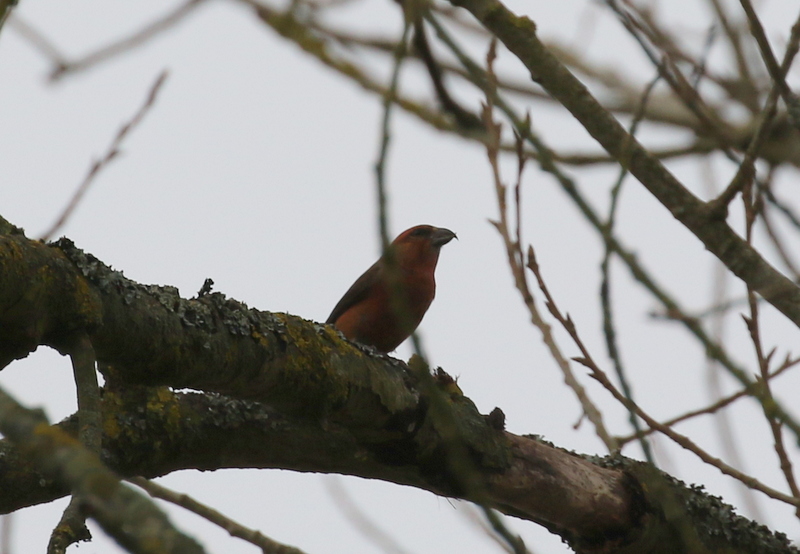 Crossbill – this male was singing high in the trees
Crossbill – this male was singing high in the trees
Eventually, we heard what we assumed was the same Lesser Spotted Woodpecker again, calling a little further back along the path. We walked back, but when it called again we realised it was already across the river. We just saw it fly back through the alders on the other side, deep into the trees. When what we assume was the same bird flew in closer calling again, we just managed to get a quick look at it and we realised it was the male, as its red crown caught the light. However, it was not easy to see any more than a small shape as it flew quickly between the trees, and it didn’t settle for more than a second. Then it flew off south and disappeared. It was getting to the time when we needed to be looking for Goshawks, so we made our way back to the car.
It had brightened up and the sun was trying to burn off the last of the mist by the time we had positioned ourselves overlooking the Forest. It was not long before we were watching our first Goshawk, a young female. Through the scope, we could see its orange-tinted underparts and darker brown upperparts, as it banked and circled.
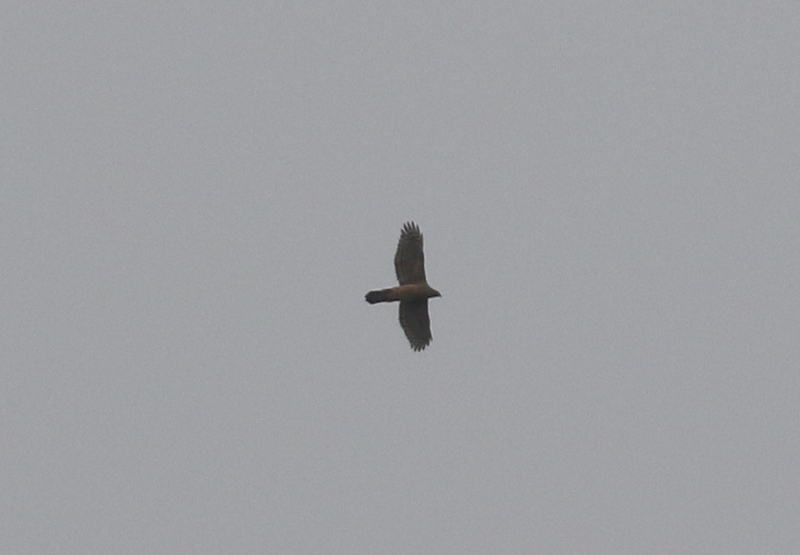 Goshawk – a young female
Goshawk – a young female
Over the next hour, the juvenile Goshawk was on show pretty much constantly. As well as circling for long periods, it performed a slow flapping display several times, flying over the treetops with exaggerated wingbeats.
As the air warmed, so other raptors circled up too. Common Buzzards of various shades were on view constantly, circling above the trees, and a pair were perched in the top of a fir tree. At one point, the Goshawk circled with a Common Buzzard, giving a great size comparison – the Goshawk being not much smaller! It even had a quick go at the Buzzard, the latter taking swift evasive action. A Red Kite drifted in from behind us and started circling, with the Goshawk and a Common Buzzard. On another occasion, a Sparrowhawk appeared and circled with the Goshawk, so we could see just how small it was by comparison. It was great to have so many other species around at the same time.
The adult Goshawks were a little more subdued this morning, possibly due to the lingering haze. We did see one adult sneak low across the tops briefly before disappearing quickly back down into the trees. But they were not displaying while we were there. Having enjoyed such good and prolonged views of the juvenile, we decided to move on and try for something else.
Our next stop was at Cockley Cley. We thought we would have a quick look for the Great Grey Shrike before lunch. It had been reported this morning in a clearing further over, near where we had seen it last time, but as we walked along the track from the road we were told it was just round the next corner. When we got there, we found it had flown off, disturbed by a dog walker, but was at least still visible. It was a long way off, perched in the top of a tall tree on the edge of the woods, but we got it in the scope to make sure we had at least all seen it, in case it flew again.
We set off to walk round to where it had gone, but before we had got very far, it flew back in our direction. The next thing we knew, the Great Grey Shrike had landed in a small tree just in front of us! It was a cracking view, especially through the scope.
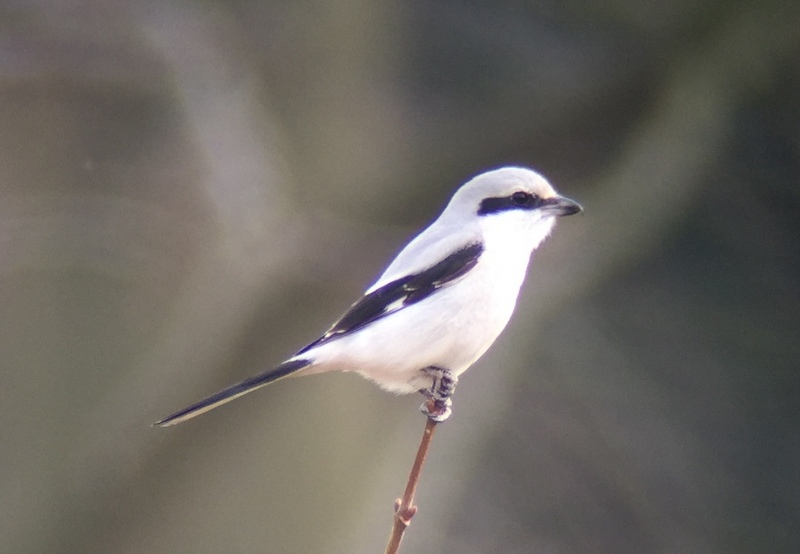 Great Grey Shrike – showed very well at Cockley Cley again
Great Grey Shrike – showed very well at Cockley Cley again
It flicked across to another branch, and then the Great Grey Shrike dropped down to the ground. When it came back up into the middle of the tree, we could see it had caught a wasp, which it proceeded to gulp down. Then it flew up into the top of another small tree nearby and stayed there for several minutes, looking around, scanning the ground. Eventually it was off again, and it flew quickly back and up into the top of a taller tree behind.
This has been a good area for Woodlarks in recent weeks, but we couldn’t hear any while we were looking at the Great Grey Shrike. We had a quick look round the nearby clearings, but all was quiet. It was perhaps a bit too disturbed here today, with lots of weekend dog walkers, as well as a steady stream of shrike watchers. We decided to walk back to the car for lunch. The sun was out now and the butterflies were out too – we saw at least one Brimstone, plus a Peacock and a Red Admiral on our walk. A smart male Yellowhammer was singing in a small tree by the path.
Over lunch on a sunny grass verge, our attention was drawn to a raptor circling overhead. It was another Goshawk, another juvenile. It circled for a while, before setting off on a burst of slow flapping display flight, before it disappeared behind the trees.
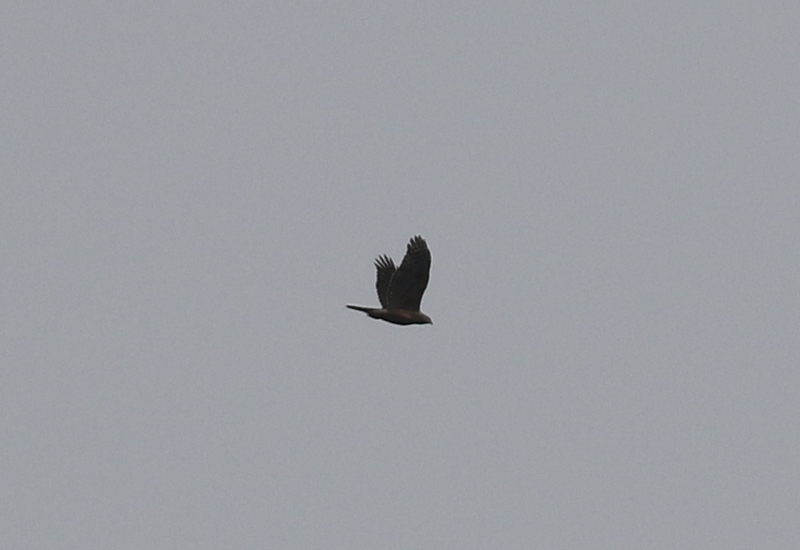 Goshawk – a different juvenile, displaying over us at lunchtime
Goshawk – a different juvenile, displaying over us at lunchtime
After lunch, we set off to try our luck for Woodlarks at a different clearing. When we arrived, it seemed rather quiet here too – it was the middle of the day and it was rather warm now. We walked slowly round the clearing, and as we made our way along one edge, we heard a Woodlark call. We couldn’t see it though, and it seemed it was probably hiding in one of the furrows. We walked up to the corner and, as we turned to come back it called again and flew back further into the field, again disappearing from view.
We kept scanning where it had landed as we walked back, and we could hear it calling periodically. Finally, our perseverance paid off as the Woodlark flew up onto a small stump and started singing. Now we could get a proper look at it through the scope.
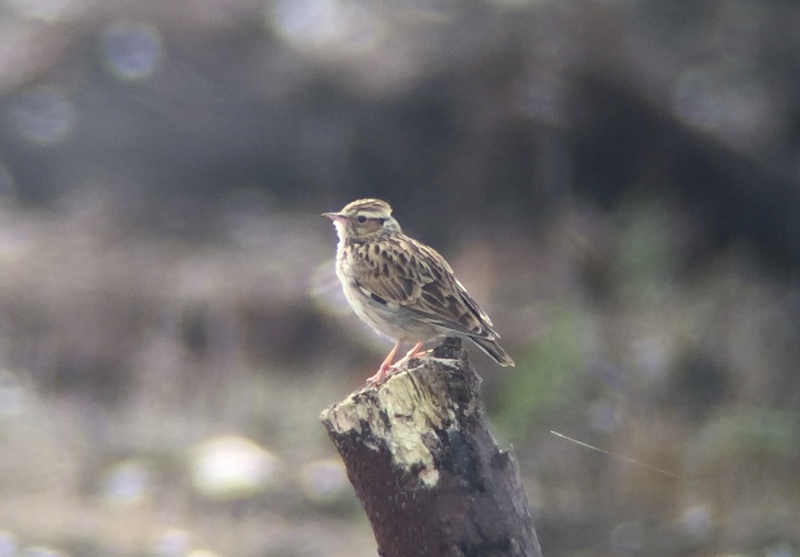 Woodlark – finally perched up singing on a stump for us
Woodlark – finally perched up singing on a stump for us
Our destination for the rest of the afternoon was back at Lynford Arboretum. As we walked along the track from the car park, there were several people looking into the trees at the feeders. We stopped ourselves and there was a nice selection of tits, plus Nuthatch and Siskin coming and going but no sign of any Hawfinches.
We walked on a little further and could hear the soft electric ‘tik!’ of Hawfinches calling from the trees. They were a bit more elusive here at first, giving us the run around for a while. There was quite a bit of disturbance today, with lots of people looking for them from the path and a dog walker walking round the paths underneath the trees with three dogs. At one point, we saw one drop down through the trees towards the feeders, but even though it had come down to the ground, it was out of view at the back and we couldn’t see it until it was disturbed and flew up again shortly after.
Eventually our persistence following the Hawfinch calls was rewarded. First, we spotted two females fly up into the bare deciduous trees behind the chicken pen. We managed to get them in the scope, before they flew over into a neighbouring fir tree, where we couldn’t see them. We stood for a while and waited to see if they would reappear. There were several smart Bramblings in the bushes and a pair of Bullfinches feeding on the buds, the bright pink male in particular looking stunning in amongst the white blackthorn blossom.
Then, a single Hawfinch flew over calling and landed over on the edge of the arboretum further down. We walked down after it, and could see three or four high in a tall bare tree, chasing each other through the branches. We were looking into the sun here, but when they flew out, one went back across the path and landed where we could get a much better look at it. A smart male, it perched there for some time, calling, giving us all a great chance to look at it through the scope before it flew off.
 Hawfinch – this male eventually showed very well
Hawfinch – this male eventually showed very well
We could still hear Hawfinches calling over by the chicken pen. We walked back and saw one fly across and land in the top of the trees above the feeders, and again had great views of it, another male, in the scope as it perched high up calling. It appeared to drop down towards the ground but we couldn’t find any sign of it from the gate.
Having enjoyed great views of Hawfinches, we decided to walk on, down to the bridge. There was a bit of bird food out on the pillars, but not many birds when we arrived. However, we could immediately hear Crossbills calling and looked out towards the paddock to see a female Crossbill preening in the top of a low, dead tree. We walked out and round the other side so that, with the light behind us, we were soon enjoying scope-filling views. Back on, we could see the brighter yellow rump contrasting with her overall grey-green plumage.
 Crossbill – we first spotted the female preening in the top of a dead tree
Crossbill – we first spotted the female preening in the top of a dead tree
Lower down in the same tree, the male Crossbill was lurking nearby. Having enjoyed fantastic views of the female, we turned our attention to him. Again, back on, his red rump was particularly bright in the afternoon sunshine. Stunning!
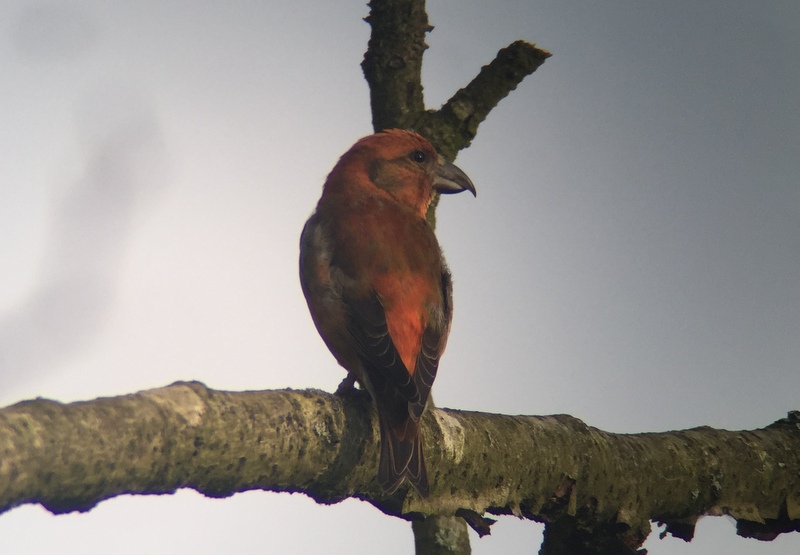 Crossbill – the bright red male was lower down in the same tree
Crossbill – the bright red male was lower down in the same tree
Looking across the paddocks, we could see the Hawfinches starting to gather in the tops of the trees. We got one in the scope, just to show everyone, but it was distant, silhouetted against the light, and not a patch on the views we had just enjoyed.
The food at the bridge is normally a magnet for tits and a great place to see Marsh Tits up close. By the time we got back, there was a lot more activity here and within a minute we had a Marsh Tit on one of the posts. It came back several times, darting in, grabbing some seed, and disappearing back into the bushes to eat it.
 Marsh Tit – coming in to the food down at the bridge
Marsh Tit – coming in to the food down at the bridge
There were several other birds coming and going too. Coal, Blue and Great Tits in particular, and a smart male Reed Bunting. While we stood and watched, we could hear more Crossbills and looked up to see at least five in the tops of the poplars high overhead.
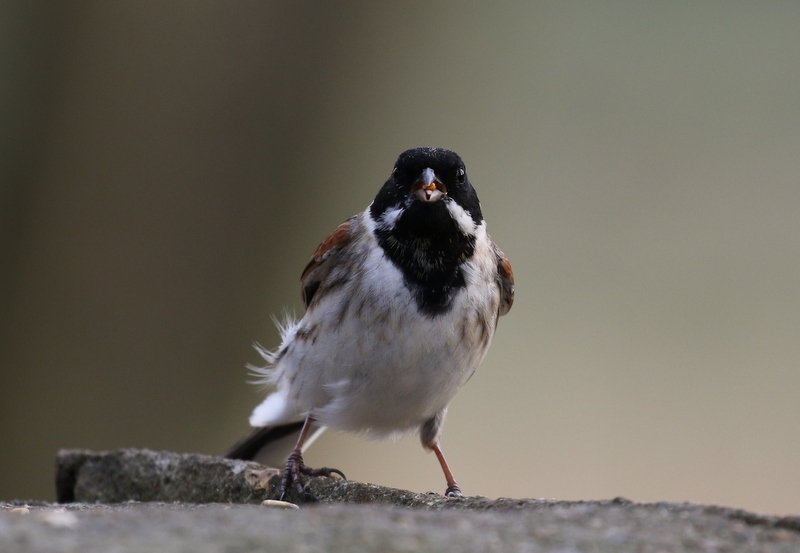 Reed Bunting – a smart male, coming to the seed too
Reed Bunting – a smart male, coming to the seed too
We finished with a quick walk round the lake. There were a few ducks, including two pairs of smart Gadwall, several Mallard and their associated domesticated brethren, plus four Canada Geese and a pair of Mute Swans. A couple of Little Grebes alternately laughed maniacally from the reeds. A Grey Wagtail flew in and landed singing briefly in a tree on the edge of the lake below the Hall, before flying across and away over our heads.
It had been a great day in the Brecks, but now, with several tired legs, it was time to head back for a well earned rest.
















